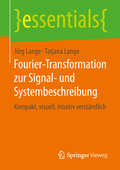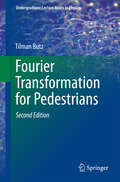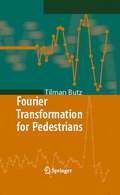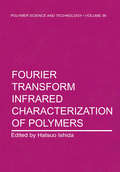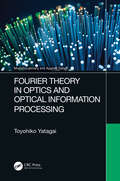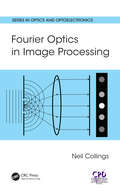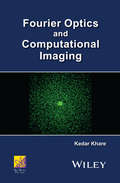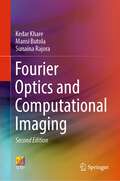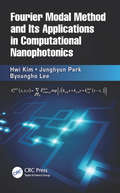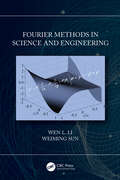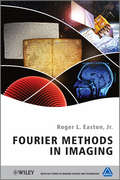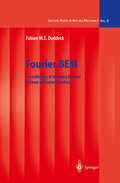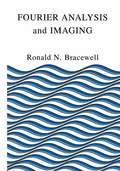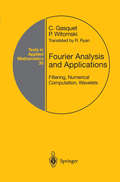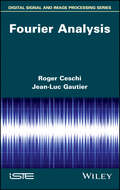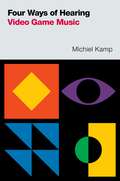- Table View
- List View
Fourier-Transformation zur Signal- und Systembeschreibung: Kompakt, visuell, intuitiv verständlich (essentials)
by Jörg Lange Tatjana LangeDie Autoren erläutern die Fourier-Transformation und ihre technischen Anwendungen, insbesondere in der Signal- und Systemtheorie, dank ihrer langjährigen Erfahrungen sehr anschaulich. Sie möchten insbesondere MINT-Studenten und natürlich auch im Beruf stehenden Absolventen helfen, die Materie besser zu verstehen. Die Autoren zeigen zudem die Wichtigkeit eines vertieften Verständnisses auf, da alle modernen digitalen Techniken – wie Ton- und Bildaufzeichnung und Speicherung, Rundfunk und Fernsehen, Mobilfunk, Signalübertragung für das Internet, moderne Regelungstechniken für Fahrzeuge oder Flugzeuge – weitgehend auf den Erkenntnissen der Fourier-Transformation basieren.Die AutorenProf. Dr.-Ing. habil. Jörg Lange war in leitender Position im Entwicklungsbereich Mobilfunk in einem Technologiekonzern tätig, bevor er in Ruhestand ging.Prof. Dr.-Ing. Tatjana Lange lehrte vor ihrem Ruhestand Automatisierungstechnik an der Hochschule Merseburg und ist weiterhin in der Forschung aktiv.
Fourier Transformation for Pedestrians (Undergraduate Lecture Notes in Physics)
by Tilman ButzThis book is an introduction to Fourier Transformation with a focus on signal analysis, based on the first edition. It is well suited for undergraduate students in physics, mathematics, electronic engineering as well as for scientists in research and development. It gives illustrations and recommendations when using existing Fourier programs and thus helps to avoid frustrations. Moreover, it is entertaining and you will learn a lot unconsciously. Fourier series as well as continuous and discrete Fourier transformation are discussed with particular emphasis on window functions. Filter effects of digital data processing are illustrated. Two new chapters are devoted to modern applications. The first deals with data streams and fractional delays and the second with the back-projection of filtered projections in tomography. There are many figures and mostly easy to solve exercises with solutions.
Fourier Transformation for Pedestrians
by Tilman ButzCovers Fourier transformation and Fourier series with a particular emphasis on window functions. Written for students and practitioners who deal with Fourier transformation. Including many illustrations and easy-to-solve exercises Presents serious science in an amusing way
Fourier Transform Infrared Spectroscopy in Food Microbiology (SpringerBriefs in Food, Health, and Nutrition)
by Avelino Alvarez-Ordóñez Miguel PrietoVibrational spectroscopy techniques, which have traditionally been used to provide non-destructive, rapid, and relevant information on microbial systematics, are useful for classification and identification. In conjunction with advanced chemometrics, infrared spectroscopy enables the biochemical signatures from microbiological structures to be extracted and analysed. In addition, a number of recent studies have shown that Fourier Transform Infrared (FT-IR) spectroscopy can help to understand the molecular basis of events, such as the adaptive tolerance responses expressed by bacteria when exposed to stress conditions in the environment, i.e. environments that cells confront in food and during food processing. The proposed Brief will discuss the published experimental techniques, data-processing algorithms, and approaches used in FT-IR spectroscopy to assist in the characterization and identification of microorganisms, to assess the mechanisms of bacterial inactivation by food processing technologies and antimicrobial compounds, to monitor the spore and membrane properties of foodborne pathogens in changing environments, to detect stress-injured microorganisms in food-related environments, to assess dynamic changes in bacterial populations, and to study bacterial tolerance responses.
Fourier Transform Infrared Characterization of Polymers (Polymer Science and Technology Series #36)
by H. IshidaThis book contains the proceedings of the Symposium on FT-IR Characterization of Polymers, which was held under the auspices of the Division of Polymer Chemistry, American Chemical Society (ACS) during the annual ACS meeting in Philadelphia, August, 1984. The content of each paper has been substantially extended from the papers presented during the conference. Due to the accidental, irrecoverable loss of the entire contents of the book by the computer system used for editorial purposes, the publication of this book has been delayed more than one year over the initial scheduled date. It has been a continuous, frustrating experience for the editor as well as for the authors. An extended Murphy's law, -anything can go wrong goes multiply wrong- has been demonstrated in editor's office. It necessitated, otherwise unnecessary, repeated proof reading during which time the editor had valuable experience ~n familiarizing himself with each paper much more than usual. The papers in this book are state-of-the-art even after such a delay. It is the authors pride and integrity toward the quality of each paper that makes the value of this book long lasting, while responsibility of the loss of any timeliness rests at the editor's hand. For the purpose of official records, submission and acceptance dates must be stated. All papers had been submitted by September, 1984, and had been accepted for publication by November, 1984, after the critical review processes.
Fourier Theory in Optics and Optical Information Processing (Multidisciplinary and Applied Optics)
by Toyohiko YatagaiFourier analysis is one of the most important concepts when you apply physical ideas to engineering issues. This book provides a comprehensive understanding of Fourier transform and spectral analysis in optics, image processing, and signal processing. Written by a world renowned author, this book looks to unify the readers understanding of principles of optics, information processing and measurement. This book describes optical imaging systems through a linear system theory. The book also provides an easy understanding of Fourier transform and system theory in optics. It also provides background of optical measurement and signal processing. Finally, the author also provides a systematic approach to learning many signal processing techniques in optics. The book is intended for researchers, industry professionals, and graduate level students in optics and information processing.
Fourier Theory in Optics and Optical Information Processing (Multidisciplinary and Applied Optics)
by Toyohiko YatagaiFourier analysis is one of the most important concepts when you apply physical ideas to engineering issues. This book provides a comprehensive understanding of Fourier transform and spectral analysis in optics, image processing, and signal processing. Written by a world renowned author, this book looks to unify the readers understanding of principles of optics, information processing and measurement. This book describes optical imaging systems through a linear system theory. The book also provides an easy understanding of Fourier transform and system theory in optics. It also provides background of optical measurement and signal processing. Finally, the author also provides a systematic approach to learning many signal processing techniques in optics. The book is intended for researchers, industry professionals, and graduate level students in optics and information processing.
Fourier Optics in Image Processing (Series in Optics and Optoelectronics)
by Neil CollingsThis much-needed text brings the treatment of optical pattern recognition up-to-date in one comprehensive resource. Optical pattern recognition, one of the first implementations of Fourier Optics, is now widely used, and this text provides an accessible introduction for readers who wish to get to grips with how holography is applied in a practical context. A wide range of devices are addressed from a user perspective and are accompanied with detailed tables enabling performance comparison, in addition to chapters exploring computer-generated holograms, optical correlator systems, and pattern matching algorithms. This book will appeal to both lecturers and research scientists in the field of electro-optic devices and systems. Features: Covers a range of new developments, including computer-generated holography and 3D image recognition Accessible without a range of prior knowledge, providing a clear exposition of technically difficult concepts Contains extensive examples throughout to reinforce learning
Fourier Optics in Image Processing (Series in Optics and Optoelectronics)
by Neil CollingsThis much-needed text brings the treatment of optical pattern recognition up-to-date in one comprehensive resource. Optical pattern recognition, one of the first implementations of Fourier Optics, is now widely used, and this text provides an accessible introduction for readers who wish to get to grips with how holography is applied in a practical context. A wide range of devices are addressed from a user perspective and are accompanied with detailed tables enabling performance comparison, in addition to chapters exploring computer-generated holograms, optical correlator systems, and pattern matching algorithms. This book will appeal to both lecturers and research scientists in the field of electro-optic devices and systems. Features: Covers a range of new developments, including computer-generated holography and 3D image recognition Accessible without a range of prior knowledge, providing a clear exposition of technically difficult concepts Contains extensive examples throughout to reinforce learning
Fourier Optics and Computational Imaging (Ane/Athena Books)
by Kedar KhareThis book covers both the mathematics of inverse problems and optical systems design, and includes a review of the mathematical methods and Fourier optics. The first part of the book deals with the mathematical tools in detail with minimal assumption about prior knowledge on the part of the reader. The second part of the book discusses concepts in optics, particularly propagation of optical waves and coherence properties of optical fields that form the basis of the computational models used for image recovery. The third part provides a discussion of specific imaging systems that illustrate the power of the hybrid computational imaging model in enhancing imaging performance. A number of exercises are provided for readers to develop further understanding of computational imaging. While the focus of the book is largely on optical imaging systems, the key concepts are discussed in a fairly general manner so as to provide useful background for understanding the mechanisms of a diverse range of imaging modalities.
Fourier Optics and Computational Imaging (Ane/Athena Books)
by Kedar KhareThis book covers both the mathematics of inverse problems and optical systems design, and includes a review of the mathematical methods and Fourier optics. The first part of the book deals with the mathematical tools in detail with minimal assumption about prior knowledge on the part of the reader. The second part of the book discusses concepts in optics, particularly propagation of optical waves and coherence properties of optical fields that form the basis of the computational models used for image recovery. The third part provides a discussion of specific imaging systems that illustrate the power of the hybrid computational imaging model in enhancing imaging performance. A number of exercises are provided for readers to develop further understanding of computational imaging. While the focus of the book is largely on optical imaging systems, the key concepts are discussed in a fairly general manner so as to provide useful background for understanding the mechanisms of a diverse range of imaging modalities.
Fourier Optics and Computational Imaging
by Kedar Khare Mansi Butola Sunaina RajoraThe book is designed to serve as a textbook for advanced undergraduate and graduate students enrolled in physics and electronics and communication engineering and mathematics. The book provides an introduction to Fourier optics in light of new developments in the area of computational imaging over the last couple of decades. There is an in-depth discussion of mathematical methods such as Fourier analysis, linear systems theory, random processes, and optimization-based image reconstruction techniques. These techniques are very much essential for a better understanding of the working of computational imaging systems. It discusses topics in Fourier optics, e.g., diffraction phenomena, coherent and incoherent imaging systems, and some aspects of coherence theory. These concepts are then used to describe several system ideas that combine optical hardware design and image reconstruction algorithms, such as digital holography, iterative phase retrieval, super-resolution imaging, point spread function engineering for enhanced depth-of-focus, projection-based imaging, single-pixel or ghost imaging, etc. The topics covered in this book can provide an elementary introduction to the exciting area of computational imaging for students who may wish to work with imaging systems in their future careers.
Fourier Modal Method and Its Applications in Computational Nanophotonics
by Hwi Kim Junghyun Park Byoungho LeeMost available books on computational electrodynamics are focused on FDTD, FEM, or other specific technique developed in microwave engineering. In contrast, Fourier Modal Method and Its Applications in Computational Nanophotonics is a complete guide to the principles and detailed mathematics of the up-to-date Fourier modal method of optical analysis. It takes readers through the implementation of MATLAB® codes for practical modeling of well-known and promising nanophotonic structures. The authors also address the limitations of the Fourier modal method.Features Provides a comprehensive guide to the principles, methods, and mathematics of the Fourier modal method Explores the emerging field of computational nanophotonics Presents clear, step-by-step, practical explanations on how to use the Fourier modal method for photonics and nanophotonics applications Includes the necessary MATLAB codes, enabling readers to construct their own code Using this book, graduate students and researchers can learn about nanophotonics simulations through a comprehensive treatment of the mathematics underlying the Fourier modal method and examples of practical problems solved with MATLAB codes.
Fourier Modal Method and Its Applications in Computational Nanophotonics
by Hwi Kim Junghyun Park Byoungho LeeMost available books on computational electrodynamics are focused on FDTD, FEM, or other specific technique developed in microwave engineering. In contrast, Fourier Modal Method and Its Applications in Computational Nanophotonics is a complete guide to the principles and detailed mathematics of the up-to-date Fourier modal method of optical analysis. It takes readers through the implementation of MATLAB® codes for practical modeling of well-known and promising nanophotonic structures. The authors also address the limitations of the Fourier modal method.Features Provides a comprehensive guide to the principles, methods, and mathematics of the Fourier modal method Explores the emerging field of computational nanophotonics Presents clear, step-by-step, practical explanations on how to use the Fourier modal method for photonics and nanophotonics applications Includes the necessary MATLAB codes, enabling readers to construct their own code Using this book, graduate students and researchers can learn about nanophotonics simulations through a comprehensive treatment of the mathematics underlying the Fourier modal method and examples of practical problems solved with MATLAB codes.
Fourier Methods in Science and Engineering
by Wen L. Li Weiming SunThis innovative book discusses and applies the generalized Fourier Series to a variety of problems commonly encountered within science and engineering, equipping the readers with a clear pathway through which to use the Fourier methods as a solution technique for a wide range of differential equations and boundary value problems. Beginning with an overview of the conventional Fourier series theory, this book introduces the generalized Fourier series (GFS), emphasizing its notable rate of convergence when compared to the conventional Fourier series expansions. After systematically presenting the GFS as a powerful and unified solution method for ordinary differential equations and partial differential equations, this book expands on some representative boundary value problems, diving into their multiscale characteristics. This book will provide readers with the comprehensive foundation necessary for solving a wide spectrum of mathematical problems key to practical applications. It will also be of interest to researchers, engineers, and college students in various science, engineering, and mathematics fields.
Fourier Methods in Science and Engineering
by Wen L. Li Weiming SunThis innovative book discusses and applies the generalized Fourier Series to a variety of problems commonly encountered within science and engineering, equipping the readers with a clear pathway through which to use the Fourier methods as a solution technique for a wide range of differential equations and boundary value problems. Beginning with an overview of the conventional Fourier series theory, this book introduces the generalized Fourier series (GFS), emphasizing its notable rate of convergence when compared to the conventional Fourier series expansions. After systematically presenting the GFS as a powerful and unified solution method for ordinary differential equations and partial differential equations, this book expands on some representative boundary value problems, diving into their multiscale characteristics. This book will provide readers with the comprehensive foundation necessary for solving a wide spectrum of mathematical problems key to practical applications. It will also be of interest to researchers, engineers, and college students in various science, engineering, and mathematics fields.
Fourier Methods in Imaging (The\wiley-is&t Series In Imaging Science And Technology Ser. #21)
by Roger L. Easton Jr.Fourier Methods in Imaging introduces the mathematical tools for modeling linear imaging systems to predict the action of the system or for solving for the input. The chapters are grouped into five sections, the first introduces the imaging “tasks” (direct, inverse, and system analysis), the basic concepts of linear algebra for vectors and functions, including complex-valued vectors, and inner products of vectors and functions. The second section defines "special" functions, mathematical operations, and transformations that are useful for describing imaging systems. Among these are the Fourier transforms of 1-D and 2-D function, and the Hankel and Radon transforms. This section also considers approximations of the Fourier transform. The third and fourth sections examine the discrete Fourier transform and the description of imaging systems as linear "filters", including the inverse, matched, Wiener and Wiener-Helstrom filters. The final section examines applications of linear system models to optical imaging systems, including holography. Provides a unified mathematical description of imaging systems. Develops a consistent mathematical formalism for characterizing imaging systems. Helps the reader develop an intuitive grasp of the most common mathematical methods, useful for describing the action of general linear systems on signals of one or more spatial dimensions. Offers parallel descriptions of continuous and discrete cases. Includes many graphical and pictorial examples to illustrate the concepts. This book helps students develop an understanding of mathematical tools for describing general one- and two-dimensional linear imaging systems, and will also serve as a reference for engineers and scientists
Fourier Methods in Imaging (The Wiley-IS&T Series in Imaging Science and Technology #18)
by Roger L. Easton Jr.Fourier Methods in Imaging introduces the mathematical tools for modeling linear imaging systems to predict the action of the system or for solving for the input. The chapters are grouped into five sections, the first introduces the imaging “tasks” (direct, inverse, and system analysis), the basic concepts of linear algebra for vectors and functions, including complex-valued vectors, and inner products of vectors and functions. The second section defines "special" functions, mathematical operations, and transformations that are useful for describing imaging systems. Among these are the Fourier transforms of 1-D and 2-D function, and the Hankel and Radon transforms. This section also considers approximations of the Fourier transform. The third and fourth sections examine the discrete Fourier transform and the description of imaging systems as linear "filters", including the inverse, matched, Wiener and Wiener-Helstrom filters. The final section examines applications of linear system models to optical imaging systems, including holography. Provides a unified mathematical description of imaging systems. Develops a consistent mathematical formalism for characterizing imaging systems. Helps the reader develop an intuitive grasp of the most common mathematical methods, useful for describing the action of general linear systems on signals of one or more spatial dimensions. Offers parallel descriptions of continuous and discrete cases. Includes many graphical and pictorial examples to illustrate the concepts. This book helps students develop an understanding of mathematical tools for describing general one- and two-dimensional linear imaging systems, and will also serve as a reference for engineers and scientists
Fourier BEM: Generalization of Boundary Element Methods by Fourier Transform (Lecture Notes in Applied and Computational Mechanics #5)
by Fabian M.E. DuddeckLike FEM, the Boundary Element Method (BEM) provides a general numerical tool for the solution of complex engineering problems. In the last decades, the range of its applications has remarkably been enlarged. Therefore dynamic and nonlinear problems can be tackled. However they still demand an explicit expression of a fundamental solution, which is only known in simple cases. In this respect, the present book proposes an alternative BEM-formulation based on the Fourier transform, which can be applied to almost all cases relevant in engineering mechanics. The basic principle is presented for the heat equation. Applications are taken from solid mechanics (e.g. poroelasticity, thermoelasticity). Transient and stationary examples are given as well as linear and nonlinear. Completed with a mathematical and mechanical glossary, the book will serve as a comprehensive text book linking applied mathematics to real world engineering problems.
Fourier Analysis and Imaging
by Ronald BracewellAs Lord Kelvin said, "Fourier's theorem is not only one of the most beautiful results of modern analysis, but it may be said to furnish an indispensable instrument in the treatment of nearly every recondite question in modern physics." This has remained durable knowledge for a century, and has extended its applicability to topics as diverse as medical imaging (CT scanning), the presentation of images on screens and their digital transmission, remote sensing, geophysical exploration, and many branches of engineering. Fourier Analysis and Imaging is based on years of teaching a course on the Fourier Transform at the senior or early graduate level, as well as on Prof. Bracewell's 1995 text Two-Dimensional Imaging. It is an excellent textbook and will also be a welcome addition to the reference library of those many professionals whose daily activities involve Fourier analysis in its many guises.
Fourier Analysis and Applications: Filtering, Numerical Computation, Wavelets (Texts in Applied Mathematics #30)
by Claude Gasquet Patrick WitomskiThe object of this book is two-fold -- on the one hand it conveys to mathematical readers a rigorous presentation and exploration of the important applications of analysis leading to numerical calculations. On the other hand, it presents physics readers with a body of theory in which the well-known formulae find their justification. The basic study of fundamental notions, such as Lebesgue integration and theory of distribution, allow the establishment of the following areas: Fourier analysis and convolution Filters and signal analysis time-frequency analysis (gabor transforms and wavelets). The whole is rounded off with a large number of exercises as well as selected worked-out solutions.
Fourier Analysis and Applications: Filtering, Numerical Computation, Wavelets (Texts in Applied Mathematics #30)
by Claude Gasquet Patrick WitomskiFourier Analysis
by Roger Ceschi Jean-Luc GautierThis book aims to learn to use the basic concepts in signal processing. Each chapter is a reminder of the basic principles is presented followed by a series of corrected exercises. After resolution of these exercises, the reader can pretend to know those principles that are the basis of this theme. "We do not learn anything by word, but by example."
Fourier Analysis
by Roger Ceschi Jean-Luc GautierThis book aims to learn to use the basic concepts in signal processing. Each chapter is a reminder of the basic principles is presented followed by a series of corrected exercises. After resolution of these exercises, the reader can pretend to know those principles that are the basis of this theme. "We do not learn anything by word, but by example."
Four Ways of Hearing Video Game Music (Oxford Music / Media)
by Michiel KampFour Ways of Hearing Video Game Music offers a novel account of the ways in which video games invite us to hear and listen to their music. By taking a phenomenological approach to characterize music in video games, author Michiel Kamp asks what it is we hear in the music when we play a game. Drawing on past phenomenological approaches to music as well as studies of music listening in a variety of disciplines such as aesthetics and ecological psychology, Kamp explains four main ways of hearing the same piece of music--through background, aesthetic, ludic, and semiotic hearing. As a background, music is not attended to at all, but can still be described in terms of moods, affordances, or equipment. Aesthetic hearing is a reflective attitude that invites hermeneutic interpretation; ludic hearing on the other hand invites "playing along" to the music, either through embodied movement, or in response to the music's cinematic or theatrical connotations. Finally, in semiotic hearing, Kamp argues that we hear music as transparent symbols or signals that provide information about the state of a game. The book investigates these four categories through detailed case studies of video games from a variety of eras and genres accompanied by gameplay recordings and images on a companion website.
